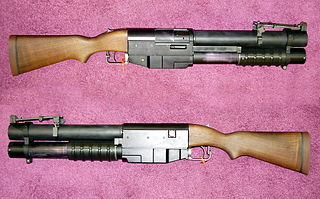| T148E1 | |
|---|---|
| Type | Grenade launcher |
| Place of origin | United States |
| Production history | |
| Designer | Springfield Armory |
| Designed | 1957-1960 |
| Specifications | |
| Length | 29.5 inches (74.9 cm) |
| Cartridge | 40mm High Explosive, 3 round magazine |
| Action | Semi-automatic percussion |
| Sights | Adjustable iron sight |
The T148E1 Grenade Launcher is an American semi-automatic grenade launcher manufactured by Springfield Armory, being the first in the T148 (sometimes written "T-148") launcher family. It fires 40mm grenades from a three-round magazine in a harmonica gun type configuration. [1]
A semi-automatic firearm, also called self-loading firearm or autoloading firearm, is one that not only fires a bullet each time the trigger is pulled, but also performs all steps necessary to prepare it to discharge again—assuming cartridges remain in the firearm's feed device. Typically, this includes extracting and ejecting the spent cartridge case from the firing chamber, re-cocking the firing mechanism, and loading a new cartridge into the firing chamber. To fire again, the trigger is released and re-pressed.

A grenade launcher is a weapon that fires a specially-designed large-caliber projectile, often with an explosive, smoke or gas warhead. Today, the term generally refers to a class of dedicated firearms firing unitary grenade cartridges. The most common type are man-portable, shoulder-fired weapons issued to individuals, although larger crew-served launchers are issued at higher levels of organisation by military forces.

The Springfield Armory, located in the city of Springfield, Massachusetts, was the primary center for the manufacture of United States military firearms from 1777 until its closing in 1968. It was the first federal armory and one of the first factories in the United States dedicated to the manufacture of weapons. The site is preserved as the Springfield Armory National Historic Site, Western Massachusetts' only unit of the national park system. It features the world's largest collection of historic American firearms.
The weapon was tested during the early part of the Vietnam War, though never officially used in combat. The already deployed Springfield Armory M79 which the design was based on was relatively new for grenadiers, although the M79 left a pause of "out of combat" to its operators due to the need to reload after each firing, which could endanger the user briefly during a firefight situation. The T148E1 was designed experimentally in an attempt to create a launcher that would solve this issue. [1]

The Vietnam War, also known as the Second Indochina War, and in Vietnam as the Resistance War Against America or simply the American War, was a conflict in Vietnam, Laos, and Cambodia from 1 November 1955 to the fall of Saigon on 30 April 1975. It was the second of the Indochina Wars and was officially fought between North Vietnam and South Vietnam. North Vietnam was supported by the Soviet Union, China, and other communist allies; South Vietnam was supported by the United States, South Korea, the Philippines, Australia, Thailand and other anti-communist allies. The war, considered a Cold War-era proxy war by some, lasted 19 years, with direct U.S. involvement ending in 1973, and included the Laotian Civil War and the Cambodian Civil War, which ended with all three countries becoming communist in 1975.

The M79 grenade launcher is a single-shot, shoulder-fired, break-action grenade launcher that fires a 40×46mm grenade, which uses what the US Army calls the High-Low Propulsion System to keep recoil forces low, and first appeared during the Vietnam War. Because of its distinctive report, it has earned the nicknames of "Thumper", "Thump-Gun", "Bloop Tube", "Big Ed", "Elephant Gun," and "Blooper" among American soldiers as well as "Can Cannon" in reference to the grenade size; Australian units referred to it as the "Wombat Gun". The M79 can fire a wide variety of 40 mm rounds, including explosive, anti-personnel, smoke, buckshot, flechette, and illumination. While largely replaced by the M203, the M79 has remained in service in many units worldwide in niche roles.

A grenadier was originally a specialized soldier, first established as a distinct role in the mid-to-late 17th century, for the throwing of grenades and sometimes assault operations. At that time grenadiers were chosen from the strongest and largest soldiers. By the 18th century, dedicated grenade throwing of this sort was no longer relevant, but grenadiers were still chosen for being the most physically powerful soldiers and would lead assaults in the field of battle. Grenadiers would also often lead the storming of fortification breaches in siege warfare, although this role was more usually fulfilled by all-arm units of volunteers called forlorn hopes, and might also be fulfilled by sappers or pioneers.
With few produced and the design program prematurely ending the manufacturing by termination of the project(s) in 1960, [2] the weapon was ultimately rejected for adoption due to being prone to jamming, [3] a result of the vulnerability to dirt and poor conditions with its chambering method, which deemed it unreliable. [1]
Currently, at least four of the launchers are on record of being in the Springfield Armory Museum's collection in Springfield, Massachusetts. [2]

Springfield is a city in the state of Massachusetts, United States, and the seat of Hampden County. Springfield sits on the eastern bank of the Connecticut River near its confluence with three rivers: the western Westfield River, the eastern Chicopee River, and the eastern Mill River. As of the 2010 Census, the city's population was 153,060. As of 2018, the estimated population was 155,032, making it the third-largest city in Massachusetts, the fourth-most populous city in New England after Boston, Worcester, and Providence, and the 12th-most populous in the Northeastern United States. Metropolitan Springfield, as one of two metropolitan areas in Massachusetts, had a population of 692,942 as of 2010.










